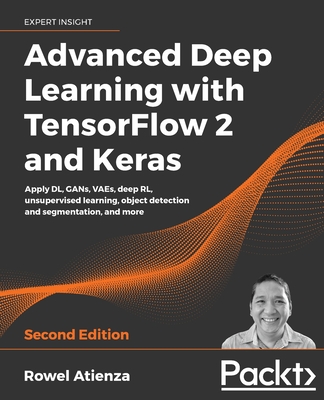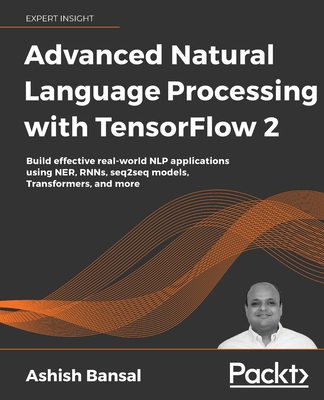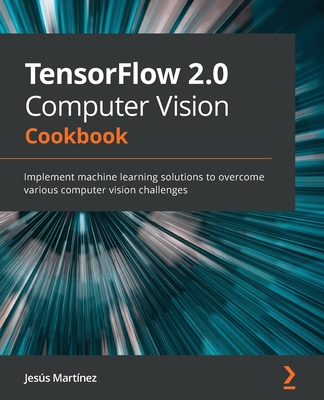Advanced Natural Language Processing with TensorFlow 2: Build real-world effective NLP applications using NER, RNNs, seq2seq models, Transformers, and
暫譯: 使用 TensorFlow 2 的進階自然語言處理:構建實際有效的 NLP 應用程式,運用 NER、RNN、seq2seq 模型、Transformers 等技術
Bansal, Ashish
- 出版商: Packt Publishing
- 出版日期: 2021-02-03
- 售價: $1,440
- 貴賓價: 9.5 折 $1,368
- 語言: 英文
- 頁數: 380
- 裝訂: Quality Paper - also called trade paper
- ISBN: 1800200935
- ISBN-13: 9781800200937
-
相關分類:
DeepLearning、TensorFlow、Text-mining
立即出貨 (庫存=1)
買這商品的人也買了...
-
 Natural Language Processing: Python and NLTK
Natural Language Processing: Python and NLTK$3,260$3,097 -
 $602知識圖譜:方法、實踐與應用
$602知識圖譜:方法、實踐與應用 -
 Advanced Deep Learning with TensorFlow 2 and Keras - Second Edition
Advanced Deep Learning with TensorFlow 2 and Keras - Second Edition$1,500$1,425 -
 Mastering Reinforcement Learning with Python: Build next-generation, self-learning models using reinforcement learning techniques and best practices (Paperback)
Mastering Reinforcement Learning with Python: Build next-generation, self-learning models using reinforcement learning techniques and best practices (Paperback)$2,010$1,910 -
 基於 BERT 模型的自然語言處理實戰
基於 BERT 模型的自然語言處理實戰$828$787 -
 $673自然語言處理:基於預訓練模型的方法
$673自然語言處理:基於預訓練模型的方法 -
 Deep Learning with Python, 2/e (Paperback)
Deep Learning with Python, 2/e (Paperback)$2,300$2,185
商品描述
One-stop solution for NLP practitioners, ML developers, and data scientists to build effective NLP systems that can perform real-world complicated tasks
Key Features
- Apply deep learning algorithms and techniques such as BiLSTMS, CRFs, BPE and more using TensorFlow 2
- Explore applications like text generation, summarization, weakly supervised labelling and more
- Read cutting edge material with seminal papers provided in the GitHub repository with full working code
Book Description
Recently, there have been tremendous advances in NLP, and we are now moving from research labs into practical applications. This book comes with a perfect blend of both the theoretical and practical aspects of trending and complex NLP techniques.
The book is focused on innovative applications in the field of NLP, language generation, and dialogue systems. It helps you apply the concepts of pre-processing text using techniques such as tokenization, parts of speech tagging, and lemmatization using popular libraries such as Stanford NLP and SpaCy. You will build Named Entity Recognition (NER) from scratch using Conditional Random Fields and Viterbi Decoding on top of RNNs.
The book covers key emerging areas such as generating text for use in sentence completion and text summarization, bridging images and text by generating captions for images, and managing dialogue aspects of chatbots. You will learn how to apply transfer learning and fine-tuning using TensorFlow 2.
Further, it covers practical techniques that can simplify the labelling of textual data. The book also has a working code that is adaptable to your use cases for each tech piece.
By the end of the book, you will have an advanced knowledge of the tools, techniques and deep learning architecture used to solve complex NLP problems.
What you will learn
- Grasp important pre-steps in building NLP applications like POS tagging
- Use transfer and weakly supervised learning using libraries like Snorkel
- Do sentiment analysis using BERT
- Apply encoder-decoder NN architectures and beam search for summarizing texts
- Use Transformer models with attention to bring images and text together
- Build apps that generate captions and answer questions about images using custom Transformers
- Use advanced TensorFlow techniques like learning rate annealing, custom layers, and custom loss functions to build the latest DeepNLP models
Who this book is for
This is not an introductory book and assumes the reader is familiar with basics of NLP and has fundamental Python skills, as well as basic knowledge of machine learning and undergraduate-level calculus and linear algebra.
The readers who can benefit the most from this book include intermediate ML developers who are familiar with the basics of supervised learning and deep learning techniques and professionals who already use TensorFlow/Python for purposes such as data science, ML, research, analysis, etc.
商品描述(中文翻譯)
針對NLP從業者、機器學習開發者和數據科學家的一站式解決方案,以構建能夠執行現實世界複雜任務的有效NLP系統
主要特點
- 使用TensorFlow 2應用深度學習算法和技術,如BiLSTMs、CRFs、BPE等
- 探索文本生成、摘要、弱監督標註等應用
- 閱讀前沿材料,GitHub庫中提供了具有完整可運行代碼的開創性論文
書籍描述
最近,NLP領域取得了巨大的進展,我們現在正從研究實驗室轉向實際應用。本書完美結合了當前流行且複雜的NLP技術的理論和實踐方面。
本書專注於NLP、語言生成和對話系統領域的創新應用。它幫助您使用流行的庫,如Stanford NLP和SpaCy,應用文本預處理的概念,包括分詞、詞性標註和詞形還原。您將從零開始構建命名實體識別(NER),使用條件隨機場和基於RNN的維特比解碼。
本書涵蓋了關鍵的新興領域,如生成用於句子完成和文本摘要的文本、通過生成圖像的標題來橋接圖像和文本,以及管理聊天機器人的對話方面。您將學習如何使用TensorFlow 2應用遷移學習和微調。
此外,它還涵蓋了可以簡化文本數據標註的實用技術。本書還提供了可根據您的用例調整的可運行代碼。
在本書結束時,您將對用於解決複雜NLP問題的工具、技術和深度學習架構有深入的了解。
您將學到什麼
- 掌握構建NLP應用程序的重要前置步驟,如POS標註
- 使用像Snorkel這樣的庫進行遷移學習和弱監督學習
- 使用BERT進行情感分析
- 應用編碼器-解碼器神經網絡架構和束搜索來摘要文本
- 使用具有注意力機制的Transformer模型將圖像和文本結合在一起
- 構建生成標題和回答有關圖像問題的應用程序,使用自定義Transformer
- 使用先進的TensorFlow技術,如學習率退火、自定義層和自定義損失函數,構建最新的DeepNLP模型
本書適合誰
這不是一本入門書籍,假設讀者熟悉NLP的基本知識,具備基本的Python技能,以及機器學習和本科級微積分、線性代數的基本知識。
最能從本書中受益的讀者包括熟悉監督學習和深度學習技術基礎的中級機器學習開發者,以及已經使用TensorFlow/Python進行數據科學、機器學習、研究、分析等目的的專業人士。
作者簡介
Ashish is an AI/ML leader, a well-known speaker, and an astute technologist with over 20 years of experience in the field. He has a Bachelor's in technology from IIT BHU, and an MBA in marketing from Kellogg School of Management. He is currently the Director of Recommendations at Twitch where he works on building scalable recommendation systems across a variety of product surfaces, connecting content to people. He has worked on recommendation systems at multiple organizations, most notably Twitter where he led Trends and Events recommendations and at Capital One where he worked on B2B and B2C products. Ashish was also a co-founder of GALE Partners, a full-service digital agency in Toronto, and spent over 9 years at SapientNitro, a leading digital agency.
作者簡介(中文翻譯)
Ashish 是一位人工智慧/機器學習領導者,知名演講者,以及一位精明的技術專家,擁有超過 20 年的相關經驗。他擁有印度理工學院瓦拉納西分校 (IIT BHU) 的技術學士學位,以及凱洛格管理學院 (Kellogg School of Management) 的行銷 MBA。他目前是 Twitch 的推薦系統總監,負責在各種產品界面上構建可擴展的推薦系統,將內容與人連接。他曾在多個組織中從事推薦系統的工作,最著名的是在 Twitter 擔任趨勢和事件推薦的負責人,以及在 Capital One 參與 B2B 和 B2C 產品的開發。Ashish 也是 GALE Partners 的共同創辦人,這是一家位於多倫多的全方位數位代理商,並在領先的數位代理商 SapientNitro 工作了超過 9 年。
目錄大綱
- Essentials of NLP
- Understanding Sentiment in Natural Language with BiLSTMs
- Named Entity Recognition (NER) with BiLSTMs, CRFs and Viterbi Decoding
- Transfer Learning with BERT
- Generating Text with RNNs and GPT-2
- Text Summarization with Seq2seq Attention and Transformer Networks
- Multi-Modal Networks and Image Captioning with ResNets and Transformer Networks
- Weakly Supervised Learning for Classification with Snorkel
- Building Conversational AI Applications with Deep Learning
- Installation and Setup Instructions for Code
目錄大綱(中文翻譯)
- Essentials of NLP
- Understanding Sentiment in Natural Language with BiLSTMs
- Named Entity Recognition (NER) with BiLSTMs, CRFs and Viterbi Decoding
- Transfer Learning with BERT
- Generating Text with RNNs and GPT-2
- Text Summarization with Seq2seq Attention and Transformer Networks
- Multi-Modal Networks and Image Captioning with ResNets and Transformer Networks
- Weakly Supervised Learning for Classification with Snorkel
- Building Conversational AI Applications with Deep Learning
- Installation and Setup Instructions for Code










